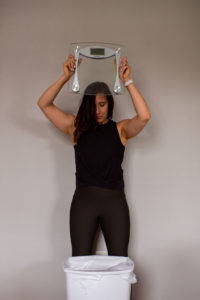You may have heard the phrase “unilateral exercise” being thrown around during a personal training session, but do you have any idea what it means? Or why your fitness professional incorporates them into your plan? Read on to find out what’s so special about these movements and why you might want to start incorporating them!
What are they?
Unilateral movements are those that use a single arm or single leg. This is as opposed to distributing the weight of the lift evenly between both sides as you would do with traditional, bilateral movements (think bench press, deadlift, squat).
Why are they awesome?
They force stabilization of your midline (aka your core)
Your core is working extra hard to help prevent you from leaning, rotating, or compensating with one side.
They mimic real life movements
And therefore help you train more “functionally”. Of course a bilateral squat mimics sitting down in a chair and a deadlift helps you learn the proper way to pick up your kids, but what about carrying something in your arm while trying to open a door? Or traveling up a set of stairs? Putting something up on a shelf with one arm while holding a child in the other? We need to train these movement patterns to be able to perform them better.
They are a sneaky way to increase volume
Volume refers to the total amount of work performed in a single workout session or over the course of a workout program. Because you are doing reps on each side, you’re doing twice the work! I guarantee completing 12 reps per leg of a split squat is going to feel very different (and harder) than doing 12 reps of a goblet squat.
They help you work on imbalances
If you have a stronger side, you don’t necessarily want to work that side and not the other. But you CAN start your unilateral movements with the weak side, which will help build strength. Working unilaterally also helps to identify these imbalances in the first place because you are not able to compensate with your “good” side as you are in bilateral movements. Training this way can also save the stronger side from fatigue or overuse. And don’t forget about the “Cross Education Effect” which describes strength gains happening in the ‘untrained’ limb when doing unilateral movements. Essentially the brain pathways used for the unilateral movement will stimulate the same muscles on the side not in use. Our bodies are so amazing!
Some examples of unilateral movements:
Lower Body:
- Lunges
- Step Ups
- Single Leg RDL or Deadlift
- B Stance RDL
- Single Leg Hip Thrust
- B Stance Hip Thrust
- Split Squat (including front or rear foot elevated)
- Suitcase Deadlift
- Carries (suitcase, waiter, front rack)
Upper Body:
- Single Arm Rows
- Single Arm Chest Press
- Single Arm Shoulder Press (Military, Push, Arnold, Z-Press)
- Single Arm Tricep Kickback
- Alternating Bicep Curls
Full Body:
- Turkish Getups
- Windmills
If you’re getting bored with the same old routine, rehabbing an injury, or seeing progress stall these movements are a great way to inject some new life into your strength training plan!



